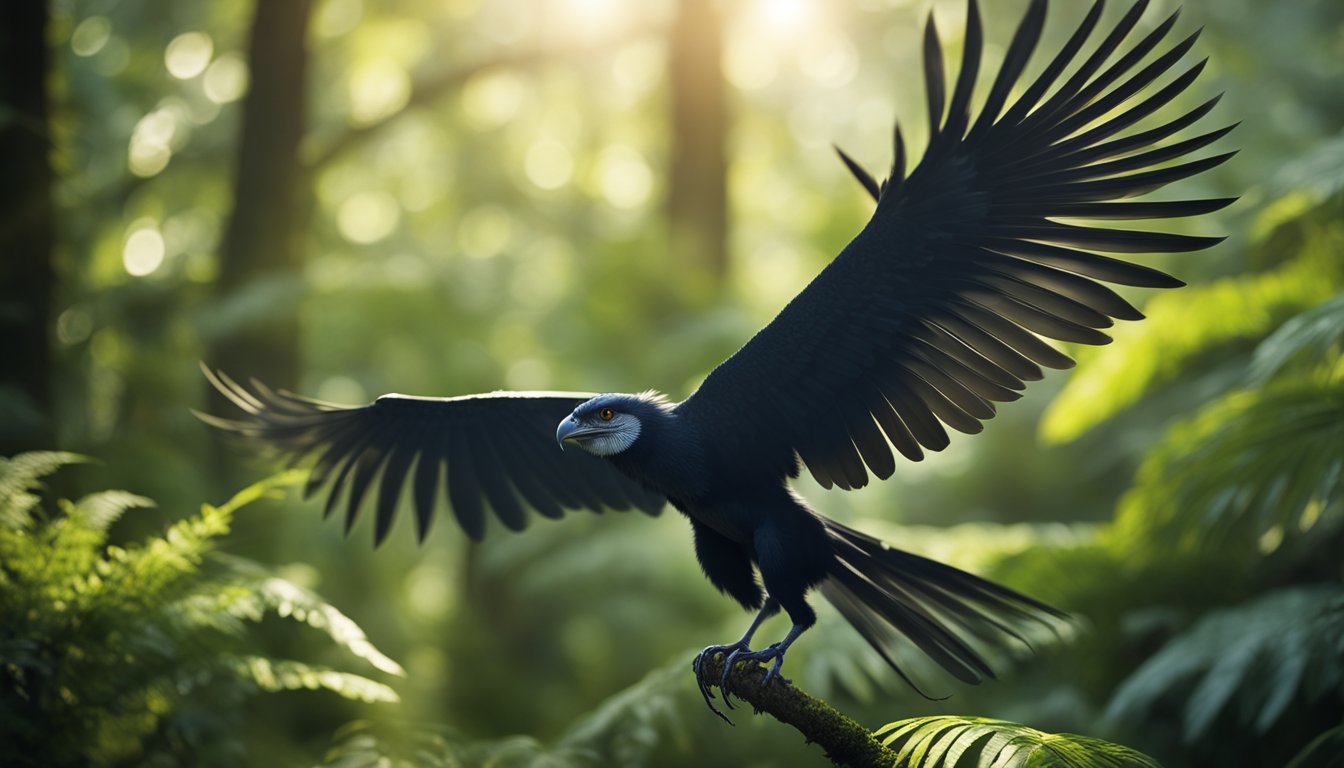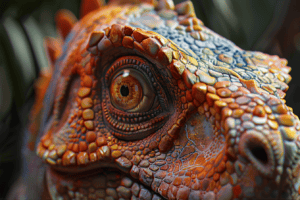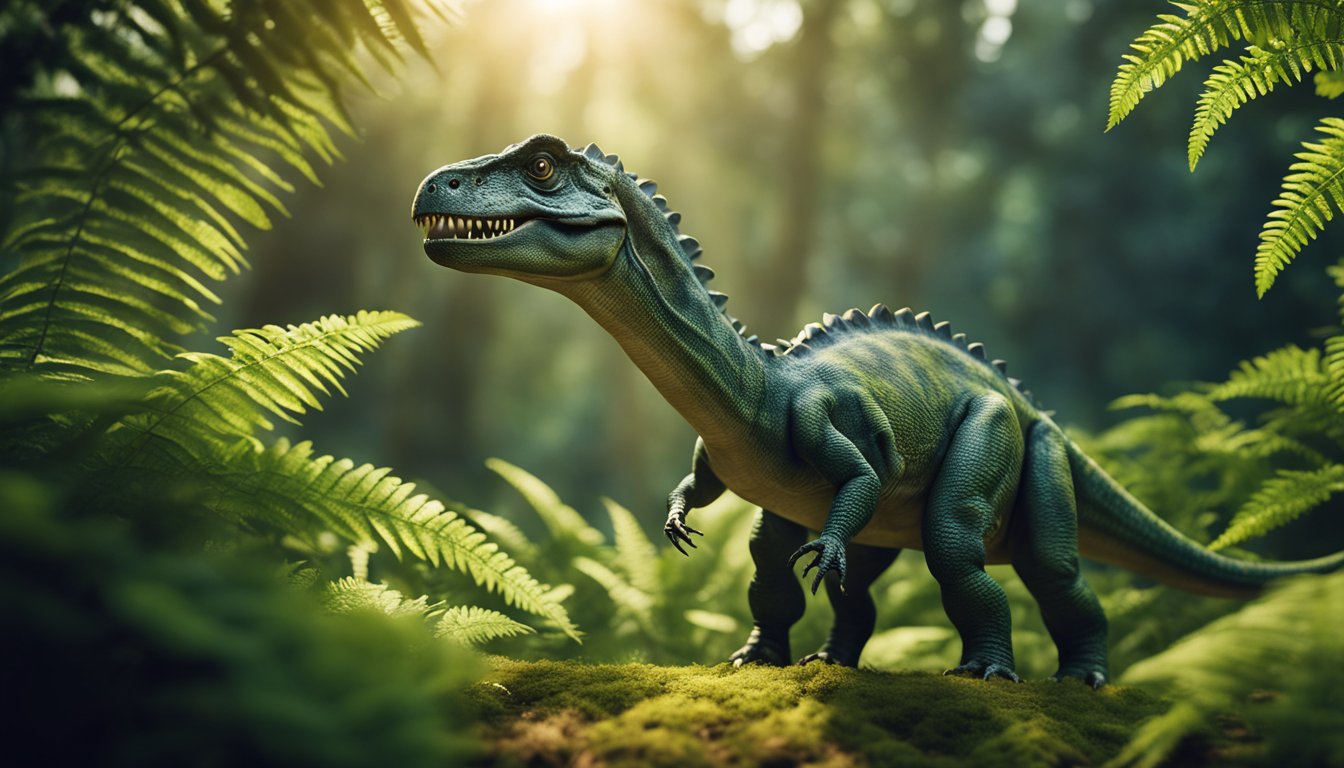Microraptor is a fascinating dinosaur that lived during the Early Cretaceous Period, about 125 million years ago.
It was a small, feathered dinosaur that had four wings, which is why it is also known as the “four-winged dinosaur.” Not only that, but Microraptor was also capable of gliding through the air, making it one of the few dinosaurs that could fly.

Despite its name, Microraptor was not a bird, but a dinosaur. It was about the size of a modern-day crow and had sharp teeth and claws.
However, what set Microraptor apart from other dinosaurs was its ability to glide.
Microraptor had long feathers on its arms and legs that acted like wings, allowing it to glide from tree to tree in search of food.
Although Microraptor is not the only dinosaur that could fly, it is one of the most unique.
Its four wings and gliding abilities make it stand out from other flying dinosaurs.
Scientists are still studying Microraptor to learn more about its flight capabilities and how it evolved.
With its fascinating features and mysterious past, Microraptor is a dinosaur that continues to captivate and intrigue scientists and dinosaur enthusiasts alike.
Unveiling the Microraptor
Discovery in China
The Microraptor, a small four-winged dinosaur, was first discovered in Liaoning, China, in the year 2000 by Xu Xing, a renowned Chinese paleontologist.
The fossilized remains of the Microraptor were found in the lakebeds of Liaoning, a region famous for its rich deposits of fossils.
Xu named the dinosaur Microraptor, which means “small thief,” due to its unique anatomy that allowed it to glide through the air like a thief in the night.
Unique Anatomy of a Four-Winged Wonder
The Microraptor is a fascinating dinosaur with a unique anatomy that sets it apart from other dinosaurs.
It had four wings, two on its arms and two on its legs, making it the only known dinosaur to have this feature.
The wings were not like those of modern birds, but rather had feathers that were long and symmetrical, giving it a sleek and aerodynamic appearance.
The tail of the Microraptor was long and feathered, and it was used to help stabilize the dinosaur as it glided through the air.
The Microraptor’s arms and legs were also unique, with long and slender bones that allowed it to move its wings and legs in a way that no other dinosaur could.
The arms were positioned in a way that allowed the wings to fold up tightly against the body when not in use, while the legs were positioned in a way that allowed the wings to spread out and provide maximum lift when gliding.
Scientists believe that the Microraptor was not capable of true flight, but rather used its four wings to glide through the air from tree to tree, much like a flying squirrel.
The gliding ability of the Microraptor was made possible by the unique combination of its feathered wings and long, slender limbs.
In conclusion, the Microraptor is a fascinating dinosaur with a unique anatomy that sets it apart from other dinosaurs.
Its discovery in China has helped scientists better understand the evolution of flight in birds and other animals.
The Microraptor’s four wings, long and slender limbs, and feathered tail make it a four-winged wonder that continues to capture the imagination of scientists and dinosaur enthusiasts alike.
The Science of Gliding

Microraptor, the four-winged dinosaur, was capable of gliding between trees. But how exactly did it achieve this feat?
Let’s explore the science of gliding and how Microraptor soared through the air.
How Microraptor Soared Between Trees
Microraptor had a unique wing configuration that allowed it to glide.
Its wings were arranged in a biplane configuration, with two sets of wings, one on its arms and another on its legs.
This configuration gave Microraptor greater stability and control while gliding.
Microraptor was also able to move its wings independently, allowing it to make precise adjustments to its flight path.
This was crucial for navigating through dense forests and avoiding obstacles.
Aerodynamics and Flight Performance
The aerodynamics of Microraptor’s wings were also key to its gliding ability.
Its wings had a large surface area, which generated more lift, allowing it to stay in the air for longer periods of time.
In wind tunnel experiments, scientists have found that Microraptor had a lift-to-drag ratio similar to that of modern birds.
This means that Microraptor was able to glide efficiently, with minimal loss of altitude over time.
Fun Fact: Microraptor’s wingspan was only about 1 meter, making it one of the smallest gliding animals known to science.
Overall, Microraptor’s unique wing configuration and aerodynamic performance allowed it to glide through the air with ease.
Its ability to navigate through dense forests and avoid obstacles made it a formidable predator in its time.
Microraptor’s Place in Dinosaur Evolution

Microraptor is a small, feathered dinosaur that lived during the Early Cretaceous period, about 125 million years ago.
Its unique feature is the presence of four wings, with wings on both its forelimbs and hindlimbs.
Microraptor belongs to the group of dinosaurs called dromaeosaurs, which are known for their sharp claws and bird-like features.
Link Between Dinosaurs and Birds
Microraptor is important because it provides a link between dinosaurs and birds.
It is one of the earliest known dinosaurs to have feathers, which suggests that feathers evolved in dinosaurs before the emergence of birds.
Archaeopteryx, a bird-like dinosaur that lived about 150 million years ago, is also considered to be an important transitional fossil between dinosaurs and birds.
Controversies and Revelations
The discovery of Microraptor has sparked controversy and revelations in the scientific community.
Some scientists believe that Microraptor could fly, while others think that it could only glide.
Recent studies have shown that Microraptor could glide using its four wings, but it was not capable of powered flight like modern birds.
Moreover, Microraptor’s feathers were not only used for flight but also for display and insulation.
The feathers were asymmetrical, which allowed for better control during gliding.
Microraptor’s wingspan was about 1 meter, which is relatively small compared to other flying animals.
In conclusion, Microraptor is an important dinosaur in the study of evolution.
Its unique features provide insights into the origin of flight and the link between dinosaurs and birds.
The discovery of Microraptor has opened up new avenues of research and has challenged our understanding of the evolution of flight.
Microraptor’s World

Habitat and Lifestyle
Microraptor was a small dinosaur that lived during the Early Cretaceous Period, about 125 million years ago.
It was discovered in the lakebeds of Liaoning, China. Microraptor was a tree-dwelling dinosaur that lived in a forested ecosystem.
The forest was home to many different types of trees, including conifers, cycads, and ginkgoes.
Microraptor was adapted to life in the trees, with sharp claws and long, curved toes that allowed it to grip branches firmly.
Microraptor had four wings, two on its arms and two on its legs, which helped it glide from tree to tree.
Microraptor was a carnivorous dinosaur that ate small animals, including birds, lizards, and insects.
It had sharp teeth and a powerful bite that allowed it to catch and kill its prey.
Microraptor was also able to fly short distances, which helped it to catch prey and escape from predators.
Predators and Prey
Microraptor was preyed upon by larger dinosaurs, including other dromaeosaurids like Velociraptor.
Microraptor was also vulnerable to attacks from modern birds, which are its closest living relatives.
Microraptor was well adapted to life in the trees, which helped it to avoid predators and catch prey.
Microraptor’s iridescent plumage may have also helped it to attract mates and intimidate rivals.
Microraptor was a unique dinosaur that lived in a world that was very different from our own.
Despite its small size, Microraptor was a fierce predator that was well adapted to life in the trees.
Its four wings and iridescent plumage make it one of the most fascinating dinosaurs to have ever lived.
Frequently Asked Questions

How did the Microraptor use its four wings to glide?
The Microraptor was a unique dinosaur that had four wings, with two wings on its arms and two wings on its legs.
Scientists believe that the Microraptor used its wings to glide from tree to tree, similar to a flying squirrel.
By spreading its wings, the Microraptor could control its descent and steer towards its desired landing spot.
Although it could not fly like a bird, the Microraptor was an excellent glider and could travel long distances without touching the ground.
What did the Microraptor typically eat?
The Microraptor was a carnivorous dinosaur that mainly ate small animals such as birds, lizards, and mammals.
Scientists have found evidence of Microraptor fossils with the remains of small prey in their stomachs.
The Microraptor had sharp teeth and claws that it used to catch and kill its prey.
What is the significance of the Microraptor’s unique body structure?
The Microraptor’s four wings were a unique adaptation that allowed it to glide through the air.
This adaptation was significant because it gave the Microraptor an advantage over other dinosaurs that could not glide.
The Microraptor’s unique body structure also provides scientists with valuable information about the evolution of birds.
Scientists believe that the Microraptor is a close relative of modern birds and that its four wings may have been an early step in the evolution of flight.
How large was the Microraptor compared to other dinosaurs?
The Microraptor was a small dinosaur that measured only about 2 feet long from head to tail.
It was much smaller than other dinosaurs like the T-Rex, which could grow up to 40 feet long.
Despite its small size, the Microraptor was a fierce predator that was well adapted to its environment.
What colors were Microraptor feathers?
Scientists have discovered that the Microraptor had iridescent feathers that shimmered in the light.
These feathers were black with a blue-green sheen, which would have made the Microraptor a stunning sight to behold.
The iridescent feathers may have also played a role in communication and attracting mates.
Is there any evidence that suggests how fast a Microraptor could move?
Scientists have used computer simulations to estimate the speed of the Microraptor based on its body structure and the size of its wings.
They believe that the Microraptor could glide at speeds of up to 25 miles per hour, which is faster than most modern birds can fly.
However, it is important to note that these are only estimates and that there is no direct evidence of how fast the Microraptor could move.







